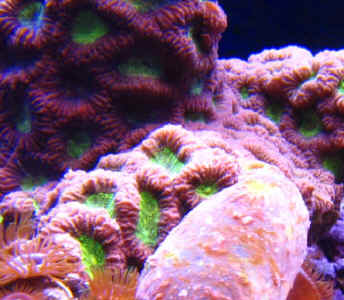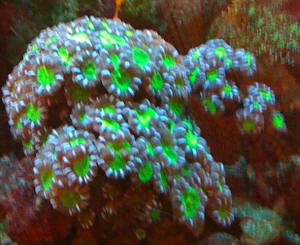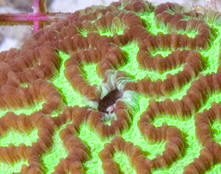|
FAQs about Faviid Coral
Selection
Related Articles: Faviid
Corals,
Related FAQs: Faviids
1, Faviids 2, Faviids 3, Faviid Identification, Faviid Behavior, Faviid Compatibility, Faviid Systems, Faviid Feeding, Faviid Disease, Faviid Reproduction/Propagation,
Stony/True Coral, Coral System Set-Up, Coral System Lighting, Stony Coral Identification, Stony Coral Selection, Coral Placement, Foods/Feeding/Nutrition, Disease/Health, Propagation, Growing Reef Corals, Stony Coral Behavior,
|

|
|
Caulastrea furcata question???? Sel. --
4/30/09
Hey Crew,
As always, thanks for your time and help.
<Welcome>
I ran into this coral yesterday at a LFS. It is a candy cane
coral which after some Google research I believe to be a
Caulastrea furcata family Faviidae.
<Agreed>
However, there seem to be many, many, many different versions of
this coral ranging anywhere from $15-40 for a 2-3" frag.
<Heee, perhaps more diversity in the asking price>
The LFS wanted $50 for one head which I thought a bit steep but
truth be told, I have never seen a candy cane coral with this
much color and vibrance.
<Really... perhaps a bit better genetically,
developmentally... better care, circumstances>
The center is a bright neon green, the rim a slight purple, and
on each head it has bright white stripes. I have attached a
picture so you can help me identify the coral in case I have
ID'd incorrectly (very possible).
<No... I think you're spot on>
The other question is, knowing that beauty is in the eye of the
beholder, is $50 per head a fair price tag?
<Bingo... If it's worth it to you, spend on!>
Thanks,
Jorge
PS - the attachment is a bad iPhone shot of the actual coral, the
link is a shot I found online that looks very similar. Though I
think the one at the LFS was nicer.
http://media.photobucket.com/image/C...yCaneCoral.jpg
<http://media.photobuck
et.com/image/Caulastrea%20furcata/Ecovatch/CandyCaneCoral.jpg>
<Ahh, thank you. Bob Fenner>
|
 |
Goniastrea 11/20/08
Hello crew,
I understand from reading through some of the posts that there are
certain species of Goniastrea that require little to no feeding at all,
only high light and good flow.
<Sorta, yeah, but they do much better if you do feed them... or
rather, feed the system well in general.>
My question is, how does one determine which species falls into this
category? I have two different colonies of Goniastrea, one with almost
mint green centers and septa that is just a shade closer towards the
brown end of the spectrum, but very little differentiation between the
two, and another smaller colony with neon green centers and stark white
septa (extremely beautiful). While I can clearly see feeding tentacles
coming out of the smaller colony at night, the larger mint green colony
send out SOOO many sweepers that you can't tell if there are any
feeding tentacles under there or not.
<cool>
As of now, I target feed both colonies, but would prefer not to add the
extra food load to the tank if feeding one of them is not really
necessary except perhaps on occasion.
<You don't really need to target feed these animals if you feed
the tank (i.e. feed your fish and everything else) well. Target feeding
is only absolutely necessary when the animal isn't readily putting
out feeders. A healthy Faviidae should do just fine
"catching" it's own food in a well fed system. I would
still target feed them every once in awhile though (just to be sure
they're getting enough).>
Jeremy Johnson
Seattle, WA
<Best,
Sara
San Diego, CA>
Maze brain selection 6/23/07 Hi Crew,
<Hi Jason, Mich with you.> I am considering purchase of a
brain "maze" coral, photo of it attached. It's quite
colorful. <A beauty!> My concern is with the hole in it, near
the top in the picture. <I see the hole, I'm not sure what
specifically caused the hole but it does look like someone may have
been living in the hole.> It's about the size of a dime. Is
that a worry, <Depends on what caused the hole. It's hard to
tell from a photo. If the tissue around the hole appears firm and
intact, it is a good sign. If it is ragged and raw, it is not a
good sign. It does not look like disease process or a recent injury
to me from what I can see in the picture. But you should inspect it
closely. To me, it looks like the former residence of a barnacle,
which would not be concerning.><<Or... a myriad of other
"lived-in" possibilities. RMF>> or should I go for
it? <Only you can determine this.><<RMF would ignore
the hole>> Thanks as always!
<Welcome as always! Mich>
Jason |
|
 
|
Australogyra zelli - 01/14/2006 Hello. <Hi Kevin.> Long
time reader, first time writer (or something like that). <Hi,
I'm Josh. I'm an aquaholic.> Anyway, can you tell me
anything about Australogyra zelli? <Nothing from personal
experience.> All I've been able to find on the web is that there
aren't many colonies in captivity. Some pages say this is because
it's a very rare import, while others say it's difficult to
keep. <Both are accurate.> I recently saw a colony for sale and
was mesmerized by it's uniqueness and beauty. I'd definitely
like to give it a try if it's not too ungodly hard to keep.
<Understood. It's not often imported so there's not much
info. available on keeping them. It would seem that these should only
be attempted by someone with a fair amount of "practice" on
coral care and a good eye for "reading" their cues. If
that's you, I'd say go for it before it is sold to/killed by a
less informed aquarist. Would be a good coral to add to the
"readily available" so if you try it, document everything to
help others and the hobby in general.> Thank you for you time,
Kevin. <Sorry I couldn't offer more specifics. - Josh>
Adding Caulastrea - 11/17/04 Hi all, I have a 90 gal FOWLR
that I would like to add some corals with lower light needs. I have a
50/50 pc with a total of 260 watts (4 bulbs). My tank parameters are:
ph 8.15 - 8.35 nitrites 0 ammonia 0 nitrates 5 Alk 10dKH
calcium 400 phosphates 2.0 I am interested in a Caulastrea
furcata, but be willing to try some others. Please advise. <Go for
the Caulastrea. Midway in the tank would be great. I also, like
Sarcophytons (any of them would suffice) placed midway to upper portion
of the tank, Xenia anywhere in the tank, polyps, also would be
excellent. Palythoas are always cool. Try some of the various branching
soft corals, yellow, white, or green Neptheas (NOT Dendros) colt
corals, etc. Always, and I mean always, strive to acquire captive coral
propagations. No excuses. These are the best suited for reefkeeping in
all cases, in my opinion. Ask for them at your LFS! Also, do research
your animals before purchasing. Use our site, other sites, too.
Reference books, other reef hobbyists, forums, and or reef clubs. Do
diligent research for the best results. Thanks for participating!
~Paul> Thanks Todd
|
|

